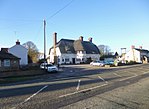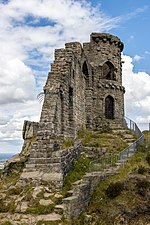Mow Cop and Scholar Green railway station
Beeching closures in EnglandDisused railway stations in CheshireFormer North Staffordshire Railway stationsNorth West England railway station stubsPages with no open date in Infobox station ... and 3 more
Railway stations in Great Britain closed in 1964Railway stations in Great Britain opened in 1849Use British English from December 2017
Mow Cop and Scholar Green railway station was a station on the North Staffordshire Railway between Stoke-on-Trent and Congleton. It served the village of Mow Cop. The line was opened by the North Staffordshire Railway on 9 October 1848 but the station at Mow Cop did not open until the beginning of January 1849. It closed in 1964 and was immortalised that year in the song Slow Train by Flanders and Swann.The signal box survived in use until 2002, and is now preserved privately in the village.
Excerpt from the Wikipedia article Mow Cop and Scholar Green railway station (License: CC BY-SA 3.0, Authors).Mow Cop and Scholar Green railway station
Drumber Lane,
Geographical coordinates (GPS) Address Nearby Places Show on map
Geographical coordinates (GPS)
| Latitude | Longitude |
|---|---|
| N 53.1188 ° | E -2.2345 ° |
Address
Mowcop & Scholar Green
Drumber Lane
ST7 3LR , Odd Rode
England, United Kingdom
Open on Google Maps







